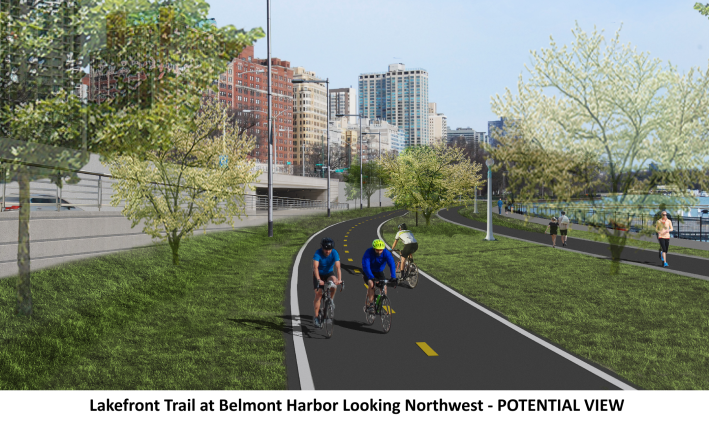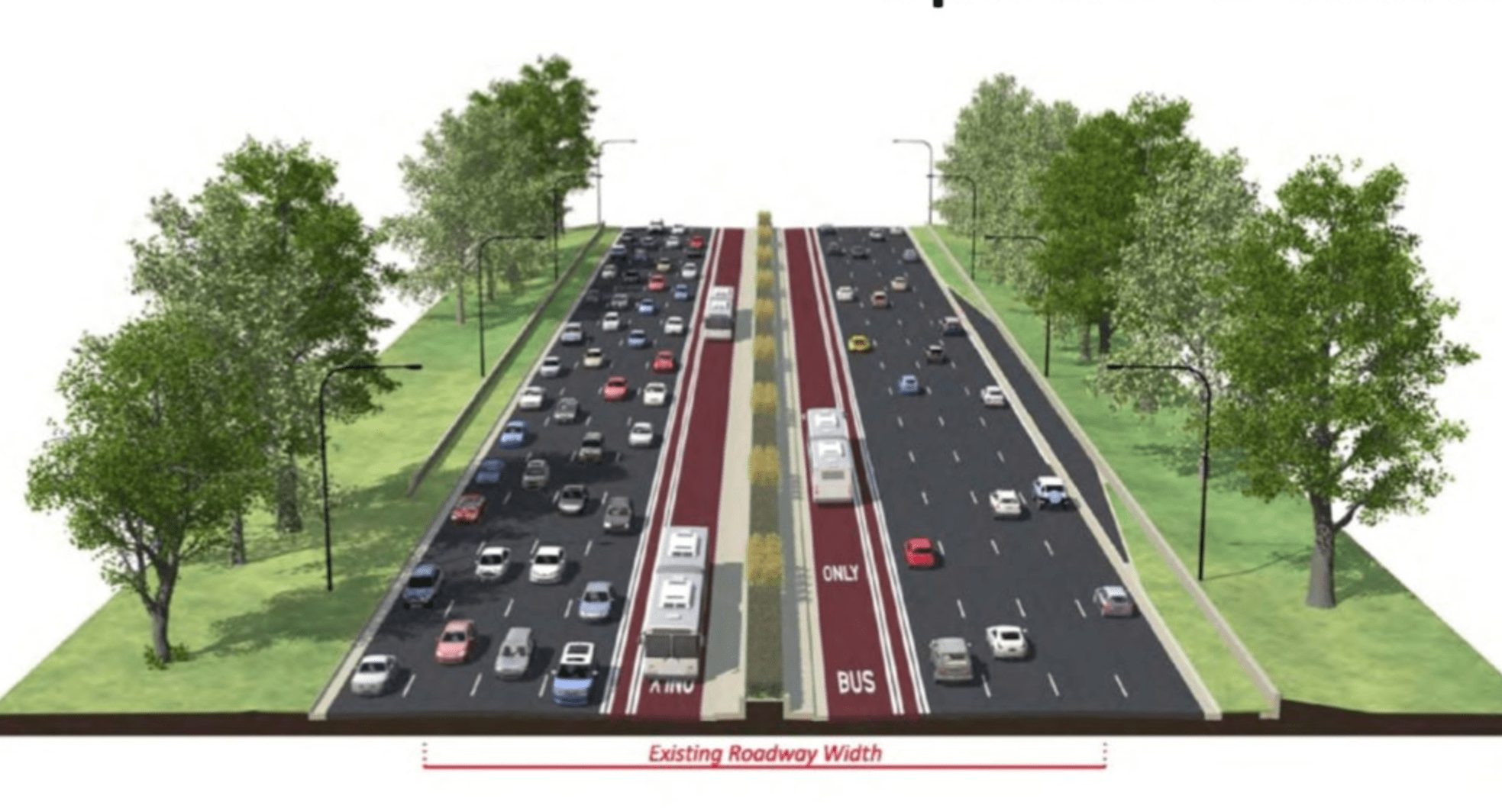Update 7/17/18, 12:30 PM: Contrary to what was reported earlier the option of adding bus-only lanes to North Lake Shore Drive without widening it actually is still on the table. However, confusingly IDOT is classifying this option under "managed lanes," the same term being used for the scenario with tolled lanes with congestion pricing, which both buses and private vehicles drivers may use. The bus-only lanes with no highway expansion option will be discussed at the next meeting. The article has been edited accordingly. I apologize for the oversight. -- John Greenfield, editor
Only a few months after the Illinois Department of Transportation showed off its most recent concepts for the Lakefront Trail as part of the North Lake Shore Drive reconstruction planning process, last week IDOT presented potential designs for transitways on the drive. This meeting marked the latest step in the process of narrowing the plans for the rehab down to three or four alternatives by the end of the year.
IDOT presented four fully-fleshed-out alternatives. “Transit Advantages” features mostly minor improvements such as bus queue jumps. “Bus on Shoulder” is similar to what Pace already does on some of their regional routes. “Dedicated Transitway – Left” features a center-running busway (i.e. to the left of the mixed-traffic lanes) with access ramps at key junctions. And “Dedicated Transitway-Off” scenario would be similar to the Transitway system in Ottawa, Ontario, which features buses on corridors above or below the normal street grade. Both Chicago transitway options would likely be built with future conversion to light rail service in mind, similar to what was eventually done in Ottawa.
Unfortunately, all of these IDOT options would involve widening Lake Shore Drive, which, with eight existing lanes, is already a massive barrier between the city and the shoreline. The department is proposing to do park expansions in conjunction with the roadwork so as not to reduce the net acreage of green space.
IDOT’s analysis found that all four configurations would perform significantly better than the existing layout, shaving off anywhere from 20 to 30 minutes in average travel times based on models using the Chicago Metropolitan Agency for Planning’s GOTO2040 data of regional travel habits plugged into a commonly used traffic flow simulation software called VISSIM. Transit ridership increase projections were also encouraging with the Dedicated Transitway – Left scenario predicted to result in a 50 percent ridership bump while the other layouts are projected to lead to a 40 percent increase.
The NSLD reconstruction is estimated to cost $2-$3 billion total. The transit improvements are projected to cost anywhere from $5-7 million for “essential improvements” to $206-248 for the Dedicated Lane options.
Surprisingly, after laying out the four different transit scenarios, IDOT officials told meeting attendees that they’re no longer considering the Bus on Shoulder and the Off-Alignment Transitway. This leaves Transit Advantage and the Center Running Transitway as the remaining candidates of these four transit-centric options.

However, the department is still considering a scenario with “managed lanes” that could be used by buses as well as motorists who pay a toll that would be raised as the number of vehicles in the lane increases, a strategy known as congestion pricing. Adding bus-only lanes to North Lake Shore Drive without widening it, the best option, is also still on the table. However, confusingly IDOT is classifying this alternative under "managed lanes." These two options will be discussed at the next NSLD task force meeting.
Here are some more details about Dedicated Transitway-Leftworthy. This alignment offers mostly center-running dedicated bus lanes with access ramps at key junctions. Unfortunately, no bus stations are proposed within the median, as IDOT says these would take up too much right-of-way. However, the ramps would all have bus priority signals and possibly gates to ensure that drivers don’t enter them.

The most significant change would be at Belmont Avenue, where the proposal calls for pushing the shoreline east into the harbor via infill. Buses would be given more dedicated space to enter and leave the drive, along with new turnarounds for the many routes that terminate in the area. This configuration would also relocate the existing northbound off-ramp and add a second on-ramp a block north at Aldine, a necessary evil if cars are to be removed from the mix at Belmont. The proposal also calls for creating separate trails for cyclists and pedestrians, with the bike trail located closer to the highway. But this could be controversial because it would likely result in worse air quality for bike riders.
While the focus of this meeting was transit, a few drivers present said they were worried about the transit improvements creating more congestion for drivers, which would certainly be a non-issue if no mixed-traffic lanes are converted. They also complained that center-running bus lanes would worsen the view from behind a windshield. There were also new concerns about IDOT’s proposal to eliminate the LSD access ramps at Wilson Avenue in light of the recent announcement that the nearby Uptown Theater will finally be reopened after being closed for decades.
The Active Transportation Alliance has pointed out that if we’re serious about reducing car dependence, the new design for the drive should involve dedicated bus lanes without widening the highway. Not only would a ten-lane drive be an even bigger barrier to lakefront use, but if private vehicle drivers have eight lanes of traffic to themselves, that will encourage even more driving. Active Trans has also noted that converting two of the existing eight lanes to congestion-priced tolled lanes for buses and drivers who pay the fee wouldn’t significantly shorten travel times for transit riders because the lanes would still be full of cars.
Fortunately, there’s still plenty of time to review the meeting materials as well as give IDOT feedback on the project. The next task force meeting happens this fall and a 4 th Public Meeting sometime during the Winter that is now extremely important to attend as this phase of the project comes to close.
For more discussion of the IDOT presentation, including some of the proposed biking and walking improvements, check out this Twitter thread from Bike Walk Lincoln Park's Michelle Stenzel.






